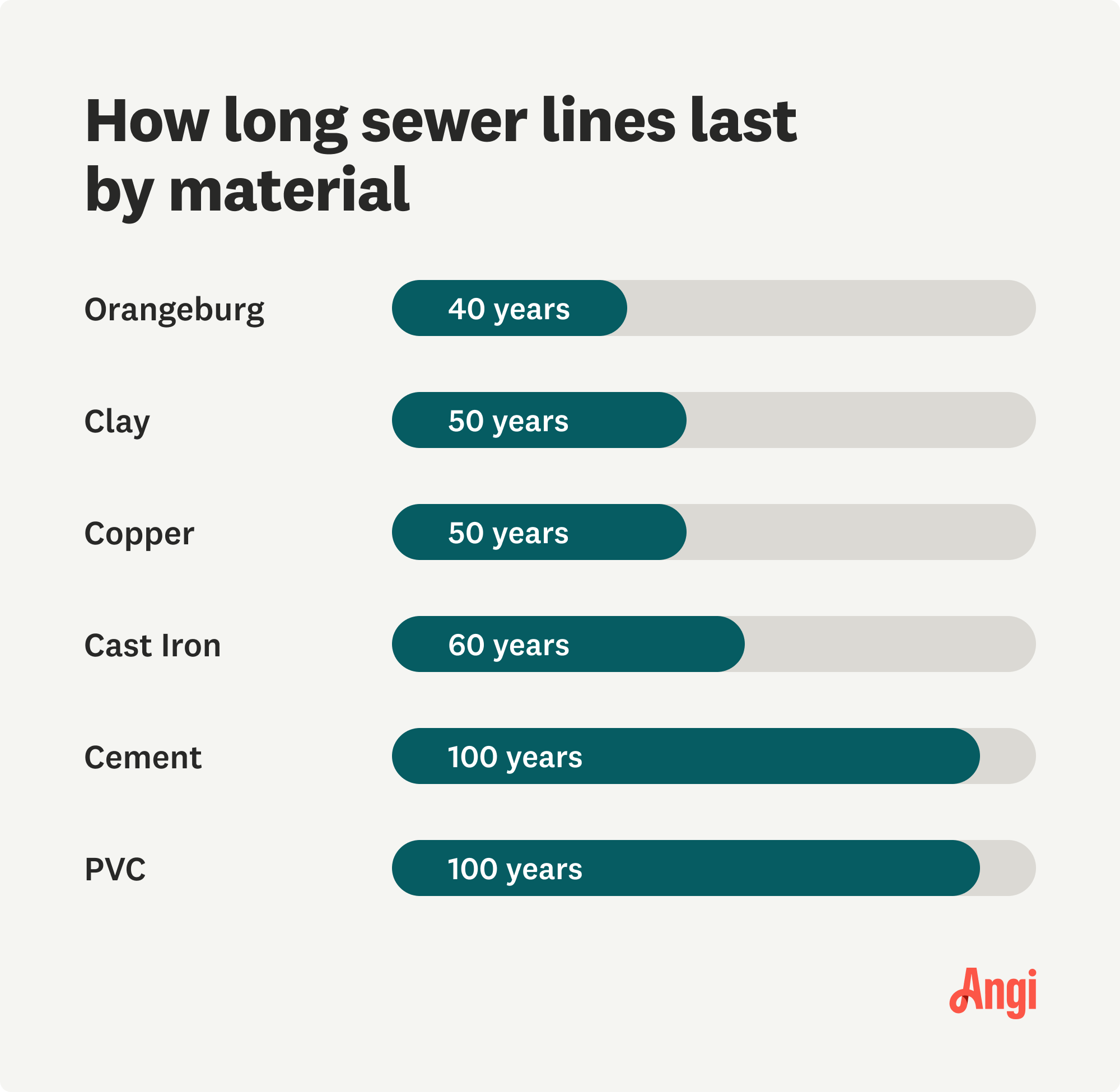
You should do a septic inspection once every one to three years to ensure you don’t have any issues. Learn about septic inspection costs before scheduling.
Tree root killer can be the solution—after thorough research—to save your sewer lines


Homes built before the 1970s may have clay pipes, which crack more easily.
Root killer starts to break down roots on contact in sewer lines.
Most tree root killers cost around $15 at a local hardware store.
If you have cracked pipes, you’ll need more than just root killer to fix your issues.
Clogged pipes can be relatively expensive to repair, so tree root killer is a tempting solution—but it’s not always the best solution, depending on your situation. So before you dump root killer down your septic system, let’s take a closer look at main sewer line clogs and ask if root killer works in certain scenarios to see if it’s the right choice for your plumbing issues.
Tree roots thrive on sewer lines because they provide what roots need most: oxygen, nutrients, and water. While annoying, it’s a fairly common occurrence—especially for homes built before the 1970s. Homes built during these times likely have clay sewer lines (compared to the PVC and ABS pipes of today) that are more prone to cracking, which gives tree roots an easier way in.
Once they’re into a pipe, roots can easily create a clog and stop plumbing in its tracks. These cracks can be small and relatively manageable, but if left untreated, they can lead to completely broken pipes. Luckily, there are a couple of easily accessible solutions that dissolve tree roots in sewer lines.
Two common types of tree root killers are available: foaming root killer and rock salt. You’ll pay between $10 and $20 to buy these at a hardware store, depending on what type you choose and how much you need. Before using any of these products, read the instructions. Working with chemicals can be dangerous to you and your surroundings, so it’s important to understand the steps before you begin.
Most chemical tree root killers work the same: Pour it down your drain, and the chemical goes to work on killing the roots. Sometimes, it may take two or three rounds to do the job.
This is the most popular chemical tree root killer on the market. It works to kill tree roots in your sewer line without killing trees or other vegetation around it. As an added benefit, foaming tree root killer also leaves behind a chemical residue that can help prevent more roots from growing in the future.
When you flush it down your toilet, the liquid root killer starts to foam and release dichlobenil. This root-killing agent travels through your line until it hits root growth. Once in contact, it starts to break down your roots. Once decayed, what’s left of the roots simply washes away with your sewage. It may take up to 12 hours for tree roots to fully decay and break off. Check the manufacturer instructions on your product for more information.
This is an easily accessible and natural option, but it can burn your skin if it gets wet, so wear plenty of hefty protective gear if you choose rock salt. To use it, let the rock salt sit in your sewer line for 12 hours without running any other water down your pipes. The salt will slowly suck out all of the moisture from the tree roots, which eventually kills the roots.
Unfortunately, if you catch the issue too late or the homeowner before you let the roots grow without action, tree root killer may not do much to solve your plumbing issues. While using root killer can be a simple fix to stop clogs, it won’t repair the cracks in your pipe caused by the root overgrowth. If your sewer issues persist even after applying tree root killer, it’s time to call in a local sewage pro.

There are a few key warning signs that your sewer line is clogged. But unfortunately, it can be hard to tell if you have tree roots in your sewer line or another type of clog, as the warning signs for both are very similar.
You may notice things like slow drainage, a gurgling toilet, or foul odors near your fixtures, like your bathtub overflow drain. But the real telltale sign that you may have tree roots growing in your sewer lines actually happens outside the home.
Standing water in your yard: You may see sinkholes appear in your yard as excess water erodes your ground and creates soft spots. This can be a sign of a cracked pipe caused by root overgrowth.
Irregular tree growth: If you notice that some of your trees are growing faster than others, it may be a sign that they’re getting some TLC from your sewer line. While your newfound landscaping may be nice to look at, your trees may be hiding the fact that their roots are in contact with your line and potentially causing damage.
While many of these symptoms may indicate tree roots in your sewer line, they may also be warning signs of other types of clogs. And although tree root killer is a proven answer to how to handle tree roots, don’t use it until you’re absolutely sure your tree is at the root of your plumbing issues.
So before you pour root killer down your drain, try cleaning your clogged sewer line first. If none of those methods work, your landscaping may be the culprit.
The best way to handle this problem is to keep the roots from getting in your sewer line in the first place. Here are a few ways to prevent your beautiful trees from becoming a costly problem.
Identifying the problem is vital to saving your sewer line. Look at the original site plans for your home to determine where your sewer lines run. Then, look to see if any trees grow along the line.
Remember, large trees can have root systems that travel far, so watch out for them, as well. If your pipes are clay and you have trees within 30 feet, there’s a fair chance your clog is caused by root problems. If not, try out other ways to unclog a drain.
While root killer is great for active invasions, you can also use it as a preventative measure. Most experts agree that using the chemical twice a year is safe. If you know you have root issues or are at risk of developing them, pour foaming root killer or rock salt down your pipes once in the spring and once in late fall.
Pipes will crack over time. It’s not a matter of if—it’s a matter of when. And if your home is at least 50 years old and has clay pipes, that may happen sooner than you think.

By replacing your old pipes sooner rather than later with more durable materials, you can bypass the inevitable cracks and costly repairs that come with delaying replacing your sewer line, like a moldy interior and a swampy exterior.
The cost to replace your sewer lines is between $60 and $250 per linear foot. Considering that the average length of a sewer line is about 60 feet from the house to the center line of the street, the final cost could fall anywhere between $3,600 to $15,000.
If you have a lot of trees in your yard or know that you have clay pipes, stay on top of the issue. One way to do that is to schedule biannual sewer line cleanings to keep things flowing smoothly.
Also consider booking an annual sewer line inspection to give you a better idea of what’s happening below before forking out the cash to replace your pipes. The average cost for a sewer line camera inspection is $685—but you may be able to negotiate a better rate if you combine it with your cleanings.
If your clay pipes have collapsed because of tree roots or you’re unsure what’s causing your plumbing problems, calling in a plumber near you can give you peace of mind and get to the bottom of the issue.
Plumbers possess the right equipment and experience to make an accurate diagnosis, then offer effective solutions such as replacing collapsed pipes or pulling out wayward roots—two things you shouldn’t attempt as an amateur.
Plus, asking for help can save you from another messy clog and further damage to your pipes.
Jess Lynk contributed to this piece.
From average costs to expert advice, get all the answers you need to get your job done.

You should do a septic inspection once every one to three years to ensure you don’t have any issues. Learn about septic inspection costs before scheduling.

Need to know what sewer line replacement costs? This guide will help you prepare to budget for sewer line replacement done by local contractors.

The cost of converting a cesspool to a septic system depends on factors like labor, complexity, and materials. Use our guide to estimate your budget.

Need to know what sewer line replacement costs in Dallas, TX? This guide will help you prepare to budget for sewer line replacement done by local contractors.

A saturated leach field can lead to costly damage to your plumbing and yard. Learn how to fix a saturated leach field with this guide.

Want to learn how to build a septic tank for your rural or off-grid property? First, check your local laws, then dive into these general guidelines.